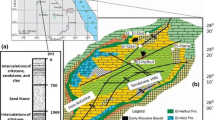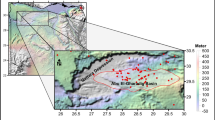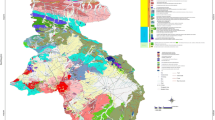Abstract
Tertiary volcanics in Egypt are basaltic flows. These are recorded in the subsurface of Nile Delta and west Cairo in the Khattatba and Abu Roash regions but exposed on Gabal Qatrani. Such flows and structure trends made west Cairo the focus of geothermal exploration. The present study aimed to discover the geothermal resource and its relation with basaltic flows and subsurface structures in the area. To achieve these aims, aeromagnetic data (TMI) map, scale 1:500,000, was used. The source parameter imaging technique was used to calculate the depth of basement rocks. The results indicated that depth to the basement varies from 700 m at Khattatba and Abu-Roash regions to 4400 m southward and at G. Muqattam in the extreme eastern parts. These results are verified by subsurface data of three drilled deep wells. The detected major structure trends run in three directions: east-west, northeast-southwest, and northwest-southwest. The Curie point depth (CPD), geothermal gradient (GG), and heat flow (HF) were all calculated using the spectral analysis technique. CPD values range from 14 km in the eastern parts of the area to 34 km in the south-west. The GG values range from 15 to 33 °C/km. The HF values range between 38 and 86 mW/m2. The high GG and HF values recorded at Khattatba and Abu-Roash are due to the basaltic flows in the subsurface. The two regions are considered reservoirs that were promising for geothermal energy. Increase in thickness of the sedimentary cover to 4000 m southward indicates the possibility of hydrocarbon occurrences.










Similar content being viewed by others
References
Aadland AJ, Hassan AA (1972) Hydrocarbon potential of the Abu Gharadig basin in the Western Desert, Egypt. 8th Arab Petrol. Cong., Algiers, No. 81(B-3)
Abdel Monem AA, Heikal MA (1981) Major element composition, magma type and tectonic environment of the Mesozoic to Recent basalts, Egypt. Bull. Fac. Earth Sci., King Abdul Aziz Uni., Jeddah 4: 121-148
Abdel Zaher M (2019) Exploration of geothermal resources in Farafra Oasis, Western Desert, Egypt, 44th Workshop on Geothermal Reservoir Engineering Stanford University, Stanford, California, SGP-TR-214
Abdel Zaher M, Elbarbary S, El-Shahat A, Mesbah H, Embaby A (2018) Geothermal resources in Egypt integrated with GIS-based analysis. J Volcanol Geotherm Res:0377–0273. https://doi.org/10.1016/j.jvolgeores
Aboud, E., Salem, A., S., Mekkawi, M., (2011): Curie depth map for Sinai Peninsula, Egypt deduced from the analysis of magnetic data, Journal of Tectonophysics 506(1):46-54, doI: https://doi.org/10.1016/j.tecto.2011.04.01
Abu El-Rus MA, Rooney TO (2017) Tertiary volcanic activity of the middle Egypt: a probe for asthenosphere-lithosphere interaction in northeast Africa. Chem Geol 455:282–303
Abu El-Rus MA, Chazot G, Vannucci R, Paquette JL, (2018) Tracing the HIMU component within Pan-African lithosphere beneath northeast Africa: evidence from Late Cretaceous Natash alkaline volcanics, Egypt. Lithos 300–301 136–153
Amer K, Samuel MD, Saleeb- Roufaiel GS (1982) Petrography and petrochemistry of the subsurface basalts of Mit Ghamr and Abu Hammad wells. Egypt J Geol 26:83–94
Aydin I, Oksum E (2010) Exponential approach to estimate the Curie-temperature depth. J Geophys Eng 7:113–125
Baldridge WS, Eyal Y, Bartov Y, Steinitz G, Eyal M (1991) Miocene magmatism of Sinai related to the opening of the Red Sea. Tectonophysics 197:181–201
Bansal AR, Gabriel G, Dimri VP, Krawczyk CM (2011) Estimation of the depth to the bottom of magnetic sources by a modified centroid method for fractal distribution of sources: an application to aeromagnetic data in Germany. Geophysics 76(3):L11–L22
Bansal AR, Anand SP, Rajaram M, Rao VK, Dimri VP (2013) Depth to the bottom of magnetic sources (DBMS) from aeromagnetic data of central India using modified centroid method for fractal distribution of sources. Tectonophysics 603:155–161
Bayoumi, A.I., Sabri, A., (1971): A contribution to magnetic anomalies in the Quatrani – El Natrun area. Bull. Fac. Sci., Cairo Univ. 40:165-173
Bhattacharyya BK, Leu LK (1975) Analysis of magnetic anomalies over Yellowstone National Park: mapping of Curie point isothermal surface for geothermal reconnaissance. J Geophys Res 80(32):4461–4465
Bhattacharyya BK, Leu LK (1977) Spectral analysis of gravity and magnetic anomalies due to rectangular prismatic bodies. Geophysics 42:41–50
Blakely RJ (1995) Potential theory in gravity and magnetic applications, Cambridge Univ. Press, Cambridge
Bowen BE, Vondra CF (1974) Paleoenvironmental interpretations of the Oligocene Gabal el Qatrani Formation, Fayum Depression, Egypt: Annals of the Geological Survey of Egypt, v. 4, p 115-138
Chapman DS, Furlong KP (1992) Thermal state of continental lower crust, in: Continental lower crust, edited by: Fountain, D.M., Arculus, R., and Kay, R. W., Elsevier Science, Amsterdam, 179–199.
Dogan G, Saibi H, Gabr A, Bloushi K, Alkaabi A (2017) Curie point depth from spectral analysis of magnetic data for geothermal reconnaissance in Mubazarah Area – Al Ain –United Arab Emirates, 1st Middle East Geoscience Student Conference 2017. UAEU, Al-Ain, 26th February to 1st March 2017
Elbarbary S, Abdel Zaher M, Mesbah H, El-Shahat A, Embaby A (2018) Curie point depth, heat flow and geothermal gradient maps of Egypt deduced from aeromagnetic data. J Renew Sustain Energy Rev 91:620–629
Endress C, Furman T, Abu El-Rus MA, Hanan BB (2011) Geochemistry of 24 Ma basalts from NE Egypt: source components and fractionation history. In: Van Hinsbergen DJJ, Buiter SJH, Torsvik TH, Gaina C, Webb SJ (eds) The formation and evolution of Africa: a synopsis of 3.8 Ga of Earth history, vol 357. Geological Society, London, Special Publications, pp 265–283
Finn CA, Ravat D (2004) Magnetic depth estimates and their potential for constraining crustal composition and heat flow in Antarctica, EOS T. Am. Geophys. Un., 85, Fall meeting Suppl., Abstract T11A-1236
Gay SP Jr. (1972) Fundamental characteristics of aeromagnetic lineaments, their geologic significance, and their significant to geology. The New Basement Tectonics. American Stereo map Company, Salt Lake City, Utah p 94
Getech (1992) The African magnetic mapping project—commercial report (unpublished)
Gingerich PD (1992) Marin mammals (Cetacea and Sirenia) from the Eocene of Gebel Mokattam and Fayum, Egypt: stratigraphy, age and paleoenvironments. University of Michigan Papers on Paleontology 30:1-84
Green CM, Barritt SD, Fairhead JD, Misener DJ (1992) The African magnetic mapping project. Extended abstract, EAEG 54th Meeting and Technical Exhibition, Paris
Hochstein MP (1990) Classification and assessment of geothermal resources. In: Dickson MH, Fanelli M (eds) Small geothermal resources: a guide to development and utilization. UNITAR, New York, pp 31–57
Hsieh HH, Chen CH, Lin PY, Yen HY (2014) Curie point depth from spectral analysis of magnetic data in Taiwan. J Asian Earth Sci 90:26–33. https://doi.org/10.1016/j.jseaes.2014.04.007
Kamba AH, Ahmed SK (2017) Depth to basement determination using source parameter imaging (SPI) of aeromagnetic data: an application to Lower Sokoto Basin, Northwest, Nigeria. International Journal of Modern Applied Physics 7(1):1–10
Komolafe AA (2010) Investigations into the tectonic lineaments and thermal structure of Lake Magadi, Southern Kenya Rift using integrated geophysical methods. Unpublished M.Sc. Thesis. International Institute of Geo-Information Science and Earth Observation, Enschede, The Netherlands
Lucassen F, Franz G, Romer RL, Pudlo D, Dulski P (2008) Nd, Pb, and Sr isotope composition of Late Mesozoic to Quaternary intra-plate magmatism in NE-Africa (Sudan, Egypt): high-l signatures from the mantle lithosphere. Contrib Mineral Petrol 156:765–784
Maden N (2010) Curie-point depth from spectral analysis of magnetic data in Erciyes stratovolcano (Central TURKEY). Pure Appl Geophys 167:349–358
Maus S, Dimri VP (1996) Depth estimation from the scaling power spectrum of potential fields. Geophys J Int 124:113–120
Miller HG, Singh V (1994) Potential field tilt—a new concept for location of potential sources. Appl Geophys 32:213–217
Moghazi A (2003) Geochemistry of a tertiary continental basalt suite, Red Sea coastal plain, Egypt: petrogenesis and characteristics of the mantle source region. Geol.Mag. 140:11–24
Mohamed HS (2021) Subsurface structures and conceptual hydrothermal model of the area lying between Quseir and Safaga area, Red Sea Coast, Egypt. Arab J Geosci 14:49. https://doi.org/10.1007/s12517-020-06294-7
Mohamed HS, Abdel Zaher M Subsurface structural features of the basement complex and geothermal resources using aeromagnetic data in the Bahariya Oasis, Western Desert, Egypt. 2019, J Pure Appl Geophys 177(2020):2791–2802. https://doi.org/10.1007/s00024-019-02369-z
Mohamed HS, Abdel Zaher M, Senosy MM, Saibi H, El Nouby M, Fairhead D (2015) Correlation of aerogravity and BHT data to develop a geothermal gradient map of the Northern Western Desert of Egypt using an artificial neural network. J Pure Appl Geophys 172(6):1585–1597
Morgan P, Boulos FK, Swanberg CA (1983) Regional geothermal exploration in Egypt. Geophys Prospect 31:361–376
Nabighian MN (1972) The analytic signal of two dimensional magnetic bodies with polygonal cross-section: its properties and use for automated anomaly interpretation. Geophysics 37(3):507–517
Norton P (1967) Rock stratigraphic nomenclature of the Western Desert. Internal Report of GPC, Cairo, Egypt, 557 p
Nur A, Ofoegbu CO, Onuoha KM (1999) Estimation of depth to the Curie point isotherm in the Upper Benue Trough, Nigeria. J Min Geol 35(1):53–60
Nwankwo LI (2015) Estimation of depths to the bottom of magnetic sources and ensuing geothermal parameters from aeromagnetic data of Upper Sokoto Basin Nigeria. Geothermics 54:76–81
Nwankwo LI, Shehu AT (2015) Evaluation of Curie-point depths, geothermal gradients and near-surface heat flown from high resolution aeromagnetic (HRAM) data of the entire Sokoto Basin, Nigeria. J Volcanol Geotherm Res 305:45–55
Oasis Montaj Programs (2014) Geosoft mapping and processing system: Version 8.3. (HJ), Inc Suit 500, Richmond St. West Toronto, ON Canada N5SIV6
Okubo Y, Graf RJ, Hansen RO, Ogawa K, Tsu H (1985) Curie point depths of the island of Kyushu and surrounding areas, Japan. Geophysics 50:481–494
Raj K, Bansal AR, Betts PG, Ravat D (2021) Re-assessment of the depth to the base of magnetic sources (DBMS) in Australia from aeromagnetic data using the defractal method. Geophys J Int 225(1):530–547. https://doi.org/10.1093/gji/ggaa601
Ravat D, Pignatelli A, Nicolosi I, Chiappini M (2007) A study of spectral methods of estimating the depth to the bottom of magnetic sources from near-surface magnetic anomaly data. Geophys J Int 169:421–434
Ravat D, Salem A, Abdelaziz AMS, Elawadi E, Morgan P (2011) Probing magnetic bottom and crustal temperature variations along the Red Sea margin of Egypt. Tectonophysics 510:337–344
Refai E, Riad S, Tealab A, (1973) The main tectonic trends of west Cairo area, Egypt: Egypt. Bull., no.2
Rittmann A (1954) Remarks on the eruptive mechanism of the Tertiary volcanoes of Egypt. Bull Volcanol 15:109–117
Ross HE, Blakely RJ, Zoback MD (2006) Testing the use of aeromagnetic data for the determination of Curie depth in California. Geophysics 71(5):L51–L59
Saibi H, Aboud E, Azizi M (2015a) Curie point depth map for Western Afghanistan deduced from the analysis of aeromagnetic data: World Geothermal Congress, 19-24 April 2015 Australia—New Zealand
Saibi H, Aboud E, Gottsmann J (2015b) Curie point depth from spectral analysis of aeromagnetic data for geothermal reconnaissance in Afghanistan. J Afr Earth Sci 111:92–99
Said R (1962) The geology of Egypt. Elsevier Publishing Company, Amsterdam, New York
Said R (1981) The geological evolution of the River Nile. Springer, 151 pp
Said R (1990) The geology of Egypt. A. A. Balkema Publishers, Rotterdam, Netherlands 734 pp.
Salem R (1976) Evolution of Eocene-Miocene sedimentation patterns in parts of northern Egypt. Am Assoc Pet Geol Bull 60:34–64
Shuey RT, Schellinger DK, Tripp AC, Alley LB (1977) Curie depth determination from aeromagnetic spectra. Geophys J R Astron Soc 50:75–101
Spector A, Grant FS (1970) Statistical models for interpreting aeromagnetic data. Geophysics 35:293–302
Stampolidis A, Kane I, Tsokas GN, Tsourlos P (2005) Curie point depths of Survey Department. Ministry of Public Works, Egypt, 84 p
Swedan AH (1991) A note on the geology of greater Cairo area. Annals of the Geological Survey of Egypt:239–251
Tanaka A, Okubo Y, Matsubayashi O (1999) Curie point depth based on spectrum analysis of the magnetic anomaly data in East and Southeast Asia. Tectonophysics 306:461–470
Thurston JB, Smith RS (1997) Automatic conversion of magnetic data to depth, dip, and susceptibility contrast using the SPITM method. Geophysics 62(3):807–813
Verduzco B, Fairhead JD, Green CM, MacKenzie C (2004) New insights into magnetic derivatives for structural mapping. Lead Edge 23:116–119
Williams GA, Small JO (1984) A study of the Oligo-Miocene basalts in the Western Desert. Proc. 7th petrol. Explor. Seminar, EGPC, Cairo: 252-268
Author information
Authors and Affiliations
Corresponding author
Ethics declarations
Conflict of interest
The author(s) declare that they have no competing interests.
Additional information
Responsible Editor: Domenico M. Doronzo
Rights and permissions
About this article
Cite this article
Mohamed, H.S., Senosy, M.M. & Salah, H. Geothermal signature of basaltic flows using aeromagnetic data, west Cairo area, Egypt. Arab J Geosci 14, 911 (2021). https://doi.org/10.1007/s12517-021-07242-9
Received:
Accepted:
Published:
DOI: https://doi.org/10.1007/s12517-021-07242-9




